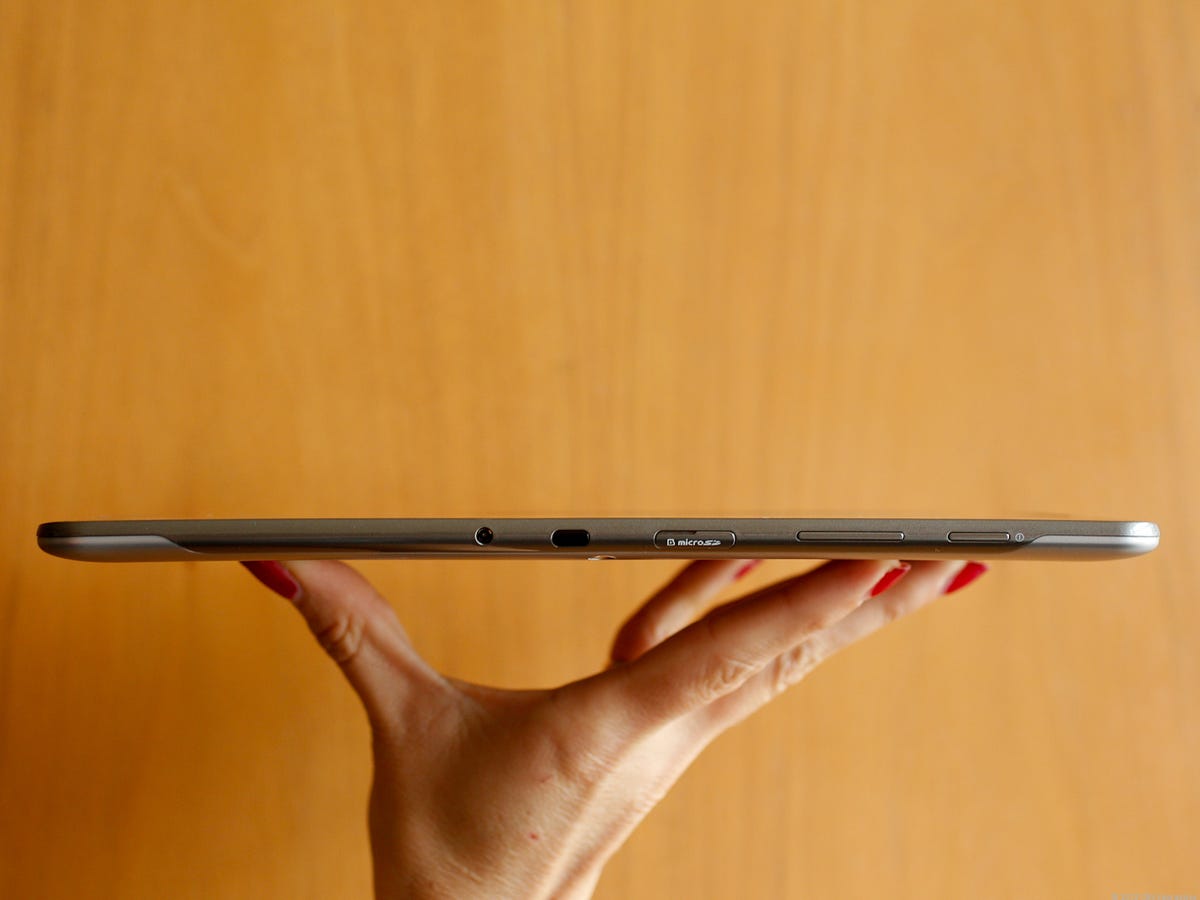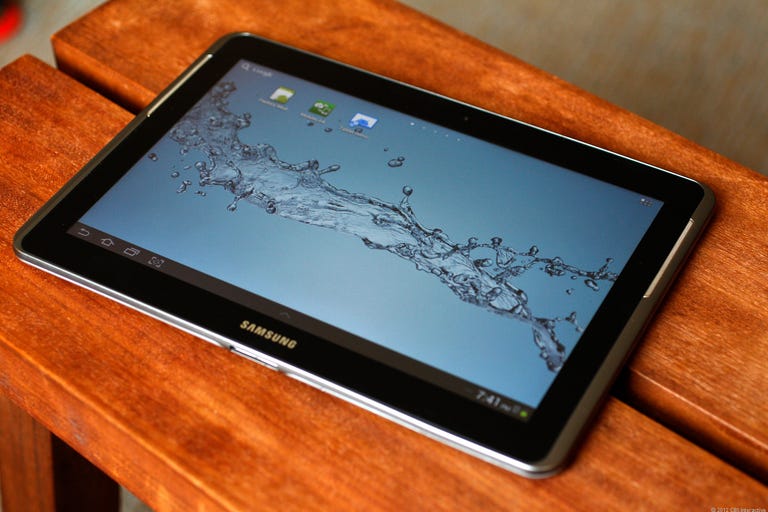 Why You Can Trust CNET
Why You Can Trust CNET Samsung Galaxy Tab 2 (10.1) review: Samsung Galaxy Tab 2 (10.1)
Samsung Galaxy Tab 2 (10.1)
The Samsung Galaxy Tab 10.1 was one of the premier Android tablets when it launched in 2011, with specs that, at the very least, matched top tier Android tablets at the time.
The Good
The Bad
The Bottom Line
Unfortunately, the Galaxy Tab 2 10.1 feels almost like a disappointing prequel, rather than a full-fledged "we've improved everything" sequel.
Design
The Samsung Galaxy Tab 2 10.1 is both slightly heavier and a bit less svelte than its predecessor, the Samsung Galaxy Tab 10.1. It still sports the same plastic backside, but now comes in titanium silver as opposed to white.

The tablet feels comfortable in my hands, but it's a bit wide and feels awkward when trying to type and hold at the same time, even if you sport alienlike Arsenio Hall-long fingers, like me. Also, the bezel isn't completely flush with the outer casing of the tablet, creating a slightly annoying edge.
| Samsung Galaxy Tab 2 10.1 | Samsung Galaxy Tab 10.1 | Asus Transformer Pad TF300 | Acer Iconia Tab A510 | |
|---|---|---|---|---|
| Weight in pounds | 1.28 | 1.24 | 1.4 | 1.48 |
| Width in inches (landscape) | 10.1 | 10.1 | 10.4 | 10.3 |
| Height in inches | 6.9 | 6.9 | 7.1 | 6.9 |
| Depth in inches | 0.38 | 0.34 | 0.38 | 0.46 |
| Side bezel width in inches (landscape) | 0.74 | 0.8 | 0.9 | 0.8 |
When held in landscape, the top edge of the tablet seats five features: from left there's a power/sleep button, a volume rocker, a 32GB capacity microSD slot, an IR blaster, and a headphone jack. In addition, two 2-inch-long speakers stretch vertically along the left and right bezel. A dock connector and microphone pinhole sit along the bottom edge.
The Galaxy Tab 2 10.1 trades in its predecessor's 2-megapixel front camera for a VGA one, and while it retains a 3-megapixel rear camera, the LED support light has been exorcised. There's no HDMI option, unfortunately, requiring you to purchase an additional accessory if you have plans to connect the tablet to a TV.
Software features
The Tab 2 10.1 is the second Samsung tablet, after the Tab 2 7.0, to ship with Ice Cream Sandwich (Android 4.0.3 to be precise) installed.
Samsung's TouchWiz UX skin is of course included and comes with custom Samsung apps like Music Hub, Media Hub, and Game Hub, a built-in screenshot app, and the Mini Apps tray located on the bottom of the screen. Tapping it brings up a tray of apps consisting of a calculator, notes, calendar, music player, and clock. However, the most useful of these is still the task manager, which allows you to quickly kill any app running in the background; this comes in handy when apps become otherwise unresponsive.
The basic look and design of ICS are retained, just with a TouchWiz skin and a few extra shortcuts for quickly turning off Wi-Fi, GPS, screen rotation, and so on. As an added bonus, Samsung offers 50GB of free Dropbox storage for the first year.
Peel's Smart Remote app
The IR blaster found on the Tab 2 7.0 makes its way to the Tab 2 10.1 and, in conjunction with Peel's included Smart Remote app, helps turn your tablet into a remote control for your TV. Peel can take the place of your cable or satellite channel guide and display a list of shows currently playing locally on your cable or satellite provider's channels. Go to the currently playing tab and click on a show, and your TV switches to the appropriate channel. Peel does a great job of holding your hand initially through a step-by-step setup wizard. The setup only requires that you know your TV manufacturer's name, your cable/satellite provider, and your ZIP code. Thankfully, Peel spares us from having to know any more-detailed information; however, be aware that Smart Remote does not work with regular monitors, only TVs or monitor/TV combos.
Once it's set up, you can browse shows by category, mark shows as favorites, or prevent shows you'd rather not see on the list from showing up again. Thankfully, Smart Remote now syncs with over-the-air listings, but its accuracy as to which shows and channels were available to me left a bit to be desired.
Navigating the interface took some getting used to, but was easy enough to pick up; however, I took issue with the method by which cable TV screen menus are controlled by the interface. Peel went with a swipe interface that requires you to flick the screen in one of four directions to highlight different menus. While this method works and after some time could be gotten used to, I would have much preferred more-direct directional controls.
As I learned with the Tab 2 10.1, Smart Remote's accuracy is very closely dictated by the information cable and satellite providers choose to release. So, while the Smart Remote guide might indicate that "Law & Order" was on right now on Channel 12, selecting it didn't always take me to the appropriate channel. In addition, sometimes the channel wasn't available to me or there was a different show on the channel at that time.
While Peel's Smart Remote is still missing some features, it's well-implemented overall. However, I'm still waiting for Hulu and Netflix integration, and an actual search feature would be useful. Also, while I found that the remote reliably functions from 10 to 20 feet away, performance is definitely more reliable within 8 feet. Also, the tablet does not handle obstructions like coffee tables as well as my normal remote does, requiring you to be much more precise when aiming it.
Hardware features
The Tab 2 10.1 houses a 1GHz dual-core OMAP 4430 CPU, 1GB of RAM, and 16GB of storage. Tablet mainstays like 802.11 b/g/n Wi-Fi support, Bluetooth 3.0, and GPS are included as well as gyroscope, accelerometer, and digital compass support.
The larger speakers deliver louder sound, but unfortunately don't exceed the apparent quality limitations most tablets adhere to.
Performance
The Tab 2 10.1 uses the same PLS-based panel tech the Tab 10.1 does, running at a resolution of 1,280x800 pixels; that's typical for most 10-inch tablets. Its clarity is as high as the original Tab's, but either there are different tiers of quality when it comes to PLS panels, or Samsung really didn't devote much time or effort to calibrating the Tab 2 10.1's color. Like the Tab 2 7.0, the Tab 2 10.1's screen looks noticeably greener and colors appear washed out compared with the original 10.1's.
| Tested spec | Samsung Galaxy Tab 2 10.1 | Samsung Galaxy Tab 10.1 | Acer Iconia Tab A510 | Asus Transformer Pad TF300 |
|---|---|---|---|---|
| Maximum brightness (Super IPS) | 380 cd/m2 | 336 cd/m2 | 353 cd/m2 | 331 cd/m2 |
| Default brightness | 213 cd/m2 | 336 cd/m2 | 118 cd/m2 | 135 cd/m2 |
| Maximum black level (Super IPS) | 0.39 cd/m2 | 0.30 cd/m2 | 0.22 cd/m2 | 0.22 cd/m2 |
| Default black level | 0.22 cd/m2 | 0.30 cd/m2 | 0.08 cd/m2 | 0.09 cd/m2 |
| Default contrast ratio | 974:1 | 1,120:1 | 1,475:1 | 1,504:1 |
| Maximum contrast ratio (Super IPS) | 968:1 | 1,120:1 | 1,604:1 | 1,500:1 |
When swiping through screens and navigating menus, the screen matches the sensitivity of some the most responsive Android screens out there, like on the Transformer Pad TF300. Also, apps launch without delay and settings menu options appear readily after tapping them.
Web and app download speeds matched most other Android tablets when within 5 feet of our test router, and even when up to 20 feet away, the connection retained much of its strength. While scrolling through Web sites was smooth, there was a noticeable degree of clipping as the processor attempted to keep up with its rendering duties. Scrolling through a page once or twice, however, solved the clipping issue.
Thanks to its hardware scalability, I used Riptide GP as a games performance benchmark. Depending on the speed of the tablet's CPU, Riptide GP will deliver a noticeable increase or decrease in frame rate. The Tab 2 10.1's TI OMAP 4430 CPU delivers decent, playable frame rates but can't approach the nearly 60fps smoothness we see on Tegra 3-based tablets. It's not choppy and it's pretty consistent, but it's just not as buttery-smooth.
Games in 2D, like Angry Birds Space, showed no signs of performance issues compared with Tegra 3 tablet performance.
As mentioned, the Tab 2 10.1 has a front-facing VGA camera and a 3-megapixel back camera. Compared with the Tab 10.1, the difference between images and video recorded on the front camera was quickly apparent. A picture of my face taken with the VGA camera, for example, lacked many embarrassing and detailed blemishes, while a similar pic from the Tab 10.1's 2-megapixel retained many of my facial "features" I'd rather people not see.
The 3-megapixel back camera fared better, capturing more details, but the Tab 2 10.1's pictures still looked washed out and lacked detail and contrast. While the Tab 10.1's camera took a longer time to focus, it resulted in higher-quality pictures.
The 720p video playback from outside sources was smooth and crisp; 1080p files that were only a couple hundred megabytes in size, played fine, but files that were larger, say 1GB looked less like a moving picture and more like a slideshow of images. That's one of the ways that Tegra 3 clearly enhances the Android tablet experience.
Our Tab 2 10.1's battery drained fairly quickly with normal use over the course of several hours. Here are our official CNET Labs-tested battery life results. More tablet testing results can be found here.
| Video battery life (in hours) | |
|---|---|
| Samsung Galaxy Tab 2 10.1 | 6.2 |
Final thoughts
Even if you're a huge fan of Samsung's Touchwiz interface and you're champing at the bit to get yer hands on a 10-inch tablet with an IR blaster, $400 for the Tab 2 10.1 is still pushing it, given its competition.
This is still a dual-core $400 tablet with 16GB of built-in storage. The quad-core Asus Transformer Pad TF300 is $20 less for the same storage and $400 gets you that tablet with 32GB of storage. The TF300 also includes Micro-HDMI and a higher-quality rear camera.
With that kind of competition, it's difficult to see the Tab 2 10.1 as anything other than an overpriced sequel that comes up short in performance and isn't exactly setting the world afire with unique features. IR blasters are nice, but can't compare with HDMI and quad-core power.


